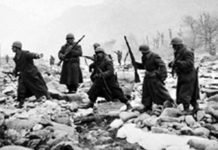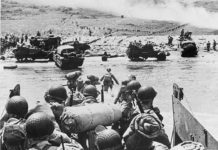From the Pacific Islands to the 19th century armies of Europe, tattoos were often used to show the soldier’s bravery and courage on the field of battle.
Tattoos are by no means a modern construct by which the dispossessed or artistic decorate themselves. The military themed tattoos of today’s contemporary combatants have a lineage that reach back not only to western antiquity, but that of the Pacific Islands as well.
The Pacific Islanders and Native Americans
For New Zealand Maori chiefs and warriors, the facial tattoos they bore spoke of their combat history, and of the warriors they had defeated in battle. The patterns of the facial tattoos of New Zealand men could be found repeated again on the body, a repetition which helped to identify the man should he be killed in a battle, and his head collected as a trophy. Amongst the indigenous tribes in the Yucatan, tattoos also played a significant cultural role. Men who proved themselves brave bore tattoos, and as they continued to display bravery and prowess in battle, their tattoos would expand as well.
Among the tribes of the lower Mississippi region in North America, men tattooed certain symbols upon themselves following the death of an enemy who had proved particularly difficult to kill. In some of the tribes men could only wear tattoos after having killed an enemy, and returned with the physical proof of a scalp to their own tribes.
Christian Soldiers and the Crusades
The early Christian Church condemned tattooing, and sought to stop the practice among the faithful. The rational behind this prohibition laid down by the Church was that tattooing damaged and altered that which was made perfect in the image of God: the human body. With the advent of the Crusades tattooing increased among the Christian warriors. As Christian soldiers marched into the Muslim world the very real threat of death arose before them. The crusaders, as religious warriors, wanted to ensure that they would be given a proper Christian burial should they die outside the borders of Christendom. The tattooing of Christian images upon their bodies was so that the crusaders could be identified as Christians, and thus buried as such.
19th Century European Soldiery
Near the close of the nineteenth century, a Professor Cesare Lombroso made a study of nearly 3,000 soldiers, and 6,000 criminals and their tattoos. This study focused upon what number of men were actually tattooed; what were the most common images or symbols used; what was the purpose behind the individual’s tattoo; and what were the most common places for a tattoo. In his studies Professor Lombroso discovered that while criminals tended to be more heavily tattooed, there were a greater percentage of soldiers than criminals with tattoos. Soldiers of the late nineteenth century, according to Lombroso, were tattooed primarily upon the arms and breasts, while criminals treated the whole body as an available canvas for their expressions.
In the European military sub-culture, it was not so much what the tattoos represented, but what they meant about the man who bore them. Tattoos, for the soldier, represented an ability to withstand voluntarily inflicted pain. Enlisted men and officers alike tattooed themselves to prove their mental strength to their fellow soldiers. This voluntary act showed the soldier’s companions that he was not only capable of withstanding pain, but that pain meant so little to him, that he inflicted it upon himself. The tattoo as used by the soldier, then, was a mark of bravery and courage.
The tattoo, regardless of the image which was chosen, was a symbolic reference to the soldier’s ability to be steadfast in the heat of battle – regardless of the soldier’s country, culture, or time period.
Sources:
- Buckland, A.W. Anthropological Studies. New York, NY: Ward and Downey, 1891.
- Hambly, Wilfrid Dyson. The History of Tattooing. Mineola, NY: Dover Publications, Inc., 2009.
- Lineberry, Cate. “Tattoos: The Ancient and Mysterious History.”








